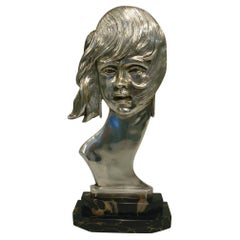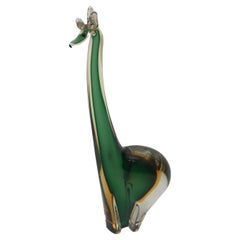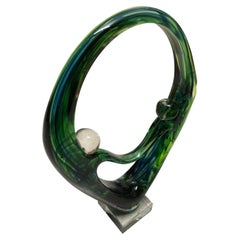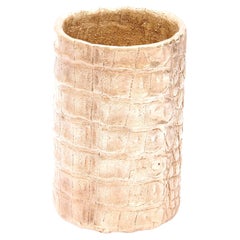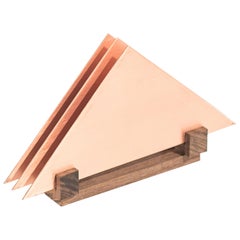South America More Desk Accessories
to
11
80
58
7
51
80
22
26
2
4
5
8
1
1
44
32
9
6
2
2
1
1
103
69
46
27
21
138
1,175
1,121
81
61
49
22
20
Height
to
Width
to
138
59
99
60
5
3
2
2
Item Ships From: South America
Art Deco Silvered Bronze Head / Bust Sculpture of a Woman / France, 1930
Located in Buenos Aires, Olivos
Art Deco bust of a woman. Silvered bronze sculpture of a lady.
Mounted over a Italian marble base. France 1930's.
Perfect desk piece or paperweight.
We have specialized in the sale ...
Category
Early 20th Century French Art Deco South America More Desk Accessories
Materials
Marble, Bronze
Giraffe Murano, 1930, Italian
Located in Ciudad Autónoma Buenos Aires, C
Murano
We have specialized in the sale of Art Deco and Art Nouveau and Vintage styles since 1982. If you have any questions we are at your disposal.
Pushing the button that reads 'Vi...
Category
1930s Italian Art Deco Vintage South America More Desk Accessories
Materials
Murano Glass
Couple of Murano, 1930, Italian
Located in Ciudad Autónoma Buenos Aires, C
Murano
We have specialized in the sale of Art Deco and Art Nouveau and Vintage styles since 1982. If you have any questions we are at your disposal.
Pushing the button that reads 'Vi...
Category
1930s Italian Art Deco Vintage South America More Desk Accessories
Materials
Murano Glass
Painted Porcelain and Hand Carved, Gold Leaf Wood Frame, Signed "Épanouissement"
By Angelo Asti
Located in Buenos Aires, Buenos Aires
Painted porcelain and hand carved, gold leaf wood frame, signed "Épanouissement", Vienna, circa 1890.
Category
Late 19th Century Austrian Vienna Secession Antique South America More Desk Accessories
Materials
Gold Leaf
Pencil Holder I by Fakasaka Design
Located in Geneve, CH
Pencil holder I by Fakasaka Design
Dimensions: Ø 8.5 cm H 13 cm
Materials: polished bronze.
Also available in dark bronze.
FAKASAKA is a design c...
Category
2010s Brazilian Modern South America More Desk Accessories
Materials
Bronze
$1,001 / item
Geometric Letter Holder
By Atelier BAM
Located in Sao Paulo, SP
Bring a warm modern touch to your stationary with this geometric Desktop accessory. Named “Triângulo”, it showcases how small leftover materials can be turned into a new object: mass...
Category
21st Century and Contemporary Brazilian Minimalist South America More Desk Accessories
Materials
Copper
$270 / item
Libidonoso Object #3 by Mameluca
Located in Geneve, CH
Libidonoso object #3 by Mameluca
Material: corian, gold-plated metal.
Dimensions: D 21 x W 18 x H 10cm.
In reference to Paul Nacke’s states about Narcissism, being an attitude o...
Category
2010s Brazilian Post-Modern South America More Desk Accessories
Materials
Metal
$3,461 / item
Libidonoso Object #2 by Mameluca
Located in Geneve, CH
Libidonoso object #2 by Mameluca
Material: gold-plated metal
Dimensions: D 15 x H 10cm
In reference to Paul Nacke’s states about Narcissism, being an attitude of a person who tr...
Category
2010s Brazilian Post-Modern South America More Desk Accessories
Materials
Metal
$3,461 / item
Turner Card and Pen Holder by Fakasaka Design
Located in Geneve, CH
Turner card and pen holder by Fakasaka Design
Dimensions: W 26.5 cm D 10.5 cm H 8 cm
Materials: black/brown bronze.
FAKASAKA is a design company focuse...
Category
2010s Brazilian Modern South America More Desk Accessories
Materials
Bronze
Kyoto Collection, Aluminium and Wood 4 Pots Set
By Luiz Costa e Rodrigo Irffi
Located in Santa Edwiges, MG
KYOTO COLLECTION
Lift up your gaze and you will see no boundaries.
(Japanese proverb)
When we learn from our precepts, we are capable of writing new stories. Looking ahead and do...
Category
2010s Brazilian Minimalist South America More Desk Accessories
Materials
Aluminum
$1,510 / set
Babel Collection, PLA N2 Organizer
By Luiz Costa e Rodrigo Irffi
Located in Santa Edwiges, MG
BABEL COLLECTION
Nothing beats the way creativity molds itself to everyday needs, as well as the sudden abstract contour of fascination.
Brazil's power to create unimaginable inve...
Category
2010s Brazilian Minimalist South America More Desk Accessories
Materials
Steel
$840 / item
Joy Collection, Steel Organizer Duo
By Luiz Costa e Rodrigo Irffi
Located in Santa Edwiges, MG
JOY COLLECTION
A thing of beauty is a joy for ever.
John Keats
I am free for the silence of shapes and colors.
Manoel de Barros
It is better to be happy than sad
Joy is the best thing there is
It is like a light inside our hearts.
Vinicius de Moraes
-
The boredom of trivial things offends creativity. It needs daily hugs, which flood life with energy and turn challenges into ideas. Without the necessary lightness, daily life consumes inspiration and pre-shaped responses fill the void.
The Joy Collection by Iludi emerges as small windows for a horizon of satisfaction and style. It colors life with three sophisticated tones and features minimalist trays, organizers, baskets and magazine holders for those who are tired of the sameness and coldness of ordinary jobs. An excellent choice to fill the home office with delicacy and energy. A perfect combination of form, function and smiles.
Measurements
N4 Organizer (Short divider...
Category
2010s Brazilian Minimalist South America More Desk Accessories
Materials
Steel
$975 / set
Joy Collection, Steel Organizer Trio
By Luiz Costa e Rodrigo Irffi
Located in Santa Edwiges, MG
JOY COLLECTION
A thing of beauty is a joy for ever.
John Keats
I am free for the silence of shapes and colors.
Manoel de Barros
It is better to be happy than sad
Joy is the best thing there is
It is like a light inside our hearts.
Vinicius de Moraes
-
The boredom of trivial things offends creativity. It needs daily hugs, which flood life with energy and turn challenges into ideas. Without the necessary lightness, daily life consumes inspiration and pre-shaped responses fill the void.
The Joy Collection by Iludi emerges as small windows for a horizon of satisfaction and style. It colors life with three sophisticated tones and features minimalist trays, organizers, baskets and magazine holders for those who are tired of the sameness and coldness of ordinary jobs. An excellent choice to fill the home office with delicacy and energy. A perfect combination of form, function and smiles.
Measurements
N1 Organizer (Long divider): 15cm x 40cm x 9cm
N2 Organizer (Short divider...
Category
2010s Brazilian Minimalist South America More Desk Accessories
Materials
Steel
$1,605 / set
Ipêrulito, Zanini De Zanine, Contemporary Brazilian Design
By Zanini de Zanine
Located in Sao Paulo, SP
Zanini de Zanine was born in Rio de Janeiro, in 1978. He worked with by Sergio Rodrigues and watched during his life the work of his father, José Zanine Caldas. Nowadays, he is one of the most awarded contemporary Brazilian...
Category
21st Century and Contemporary Brazilian South America More Desk Accessories
Libidonoso Object #1 by Mameluca
Located in Geneve, CH
Libidonoso object #1 by Mameluca
Material: marble, gold-plated metal
Dimensions: D 15 x H 5.5 cm
In reference to Paul Nacke’s states about Narcissism, being an attitude of a per...
Category
2010s Brazilian Post-Modern South America More Desk Accessories
Materials
Marble
$3,461 / item
Taylor Pencil Holder I by Fakasaka Design
Located in Geneve, CH
Taylor pencil holder by Fakasaka Design
Dimensions: Ø 8.5 cm H 13 cm
Materials: dark bronze.
Also available in polished bronze.
FAKASAKA is a design company focused on production o...
Category
2010s Brazilian Modern South America More Desk Accessories
Materials
Bronze
$1,001 / item
Set of Five Crystal Querandi Glasses and Two Bottles, Argentina, circa 1970
By Querandi Art Glass
Located in Buenos Aires, Buenos Aires
Set of five crystal Querandi glasses and two bottles. Argentina, circa 1970.
Bottles dimensions: 35,5 cm height, 10 cm width, 10 cm depth.
Glasses d...
Category
1970s Argentine Mid-Century Modern Vintage South America More Desk Accessories
Materials
Crystal
Kobe Collection, Aluminium and Wood 3 Pots Set
By Luiz Costa e Rodrigo Irffi
Located in Santa Edwiges, MG
KOBE COLLECTION
"The distinction between past, present and future is only a stubbornly persistent illusion". We must not forget what we have lived, stories and traditions, so that w...
Category
2010s Brazilian Minimalist South America More Desk Accessories
Materials
Aluminum
$1,080 / set
Recently Viewed
View AllMore Ways To Browse
Royal Dux Cat
Schlumberger Pen
Teign Valley Glass
Used Electric Typewriters
Vintage Perpetual Flip Calendar
Vintage White Wicker Vanity
1920s Gas Pump
Antique Mail Organizer
Antique Royal Typewriter
Blickensderfer Typewriter
Burroughs Adding Machine
Carl Aubock Magnifying
Copenhagen Tumbler Pot
Doulton Gaffers
Fornasetti Bell
Gargoyle Mobiloil Gas Pump Globe
George F. Cram On Sale
Hermes Mosaique Au 24 Square Plate
